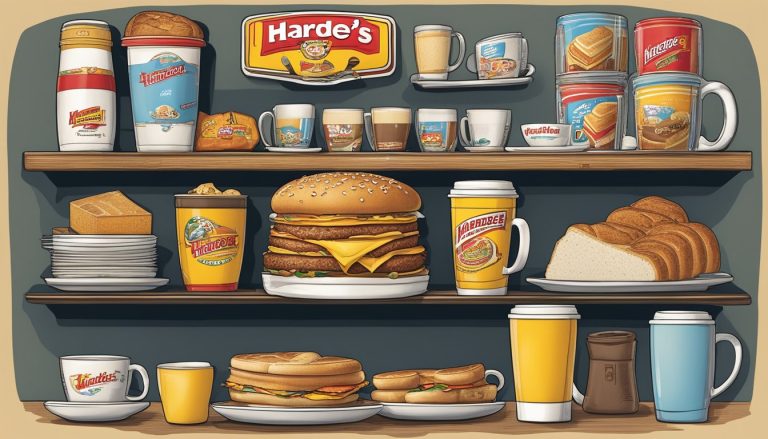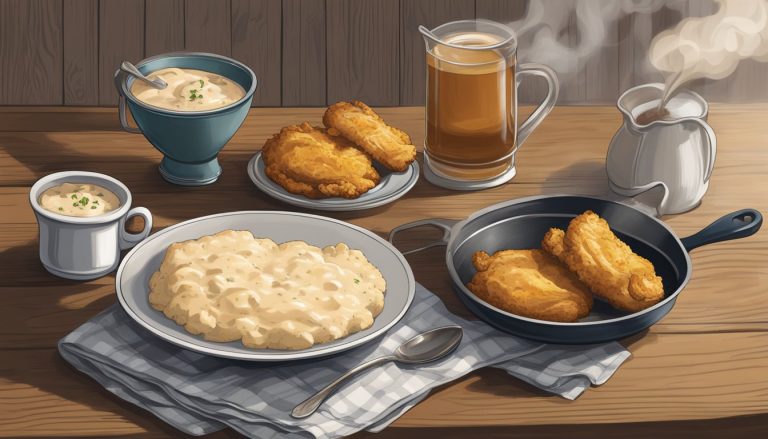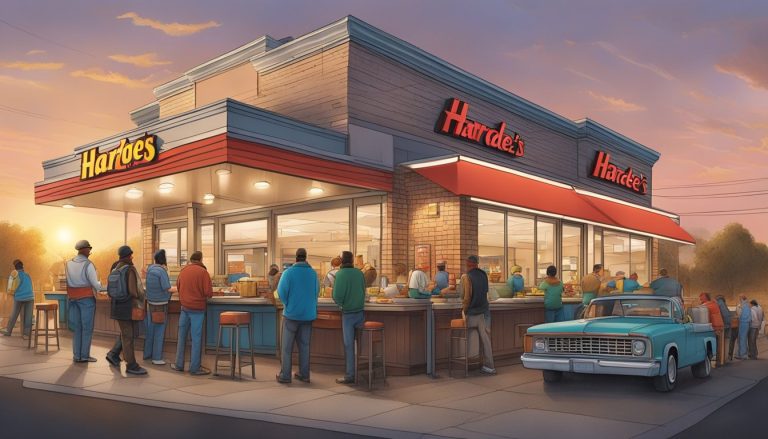Hardee’s breakfast menu once stood as a beloved staple in American morning routines. The fast-food chain’s hearty offerings reflected the broader evolution of American breakfast culture, intertwining with the nation’s growing love affair with coffee.
The rise of café culture transformed coffee from a quick morning pick-me-up into a social experience, altering American breakfast habits. Coffee shops emerged as a “third space” between home and work, fostering community and reshaping how Americans start their day. This shift influenced fast-food breakfast menus, including Hardee’s, as consumers sought more diverse and sophisticated options.
While Hardee’s no longer serves breakfast, its legacy remains part of the American breakfast story. The chain’s past offerings, from biscuits to breakfast platters, mirrored changing tastes and preferences in a nation where breakfast holds cultural significance beyond mere sustenance. The interplay between fast-food breakfast options and evolving coffee culture continues to shape American mornings.
The Emergence of Hardee’s in American Fast Food
Hardee’s rapid rise from a single restaurant to a major fast food chain reshaped the industry landscape. The company’s growth strategy and innovative menu offerings established it as a formidable competitor in the market.
Wilber Hardee and the Birth of the Franchise
Wilber Hardee opened the first Hardee’s Hamburgers in Greenville, North Carolina in 1960. The restaurant’s success was immediate, earning over $9,500 in profit during its first four months of operation.
Recognizing the potential for expansion, Hardee partnered with Leonard Rawls and Jim Gardner. Together, they developed a franchise model to grow the Hardee’s brand across the country.
The company’s signature charbroiled burgers and efficient service model appealed to consumers and franchisees alike. This approach laid the foundation for Hardee’s rapid expansion in the coming years.
Expansion and the Rise of Hardee’s
Hardee’s growth accelerated through franchising, allowing the brand to establish a strong presence in the Southern and Midwestern United States. By 1984, Hardee’s had become the fourth-largest fast food chain in America.
The company continued to evolve, introducing new menu items and refining its operations. In 1997, CKE Restaurants Holdings, Inc., the parent company of Carl’s Jr., acquired Hardee’s for $327 million.
This merger further expanded Hardee’s reach and resources. The combined company now operates over 3,000 locations, including 1,901 Hardee’s restaurants. Hardee’s continues to innovate, embracing digital marketing strategies and maintaining its position as a major player in the fast food industry.
The Role of Breakfast at Hardee’s

Hardee’s breakfast offerings play a significant part in the fast-food landscape. The chain’s morning menu combines traditional American breakfast fare with unique items that have become customer favorites.
Decoding the Hardee’s Breakfast Menu
Hardee’s breakfast menu features a variety of options to suit different tastes. Biscuits form the cornerstone of many menu items, with the Made from Scratch Biscuits™ being a popular choice.
Egg-based dishes are prevalent, including the Loaded Omelet Biscuit and the Frisco Breakfast Sandwich. For heartier appetites, the Breakfast Platter combines eggs, hash rounds, and a choice of meat.
Several breakfast sandwiches cater to on-the-go customers. The Monster Biscuit™ stacks ham, bacon, egg, and cheese on a freshly baked biscuit.
Breakfast Hours and Customer Patterns
Hardee’s typically serves breakfast from 6:00 AM to 10:30 AM. This timeframe aligns with the morning routines of many customers, from early risers to late-morning brunchers.
Biscuit preparation begins at 4:00 AM, ensuring fresh batches every 15 minutes. This commitment to freshness is a key factor in customer satisfaction.
Peak breakfast hours often occur between 7:00 AM and 9:00 AM, coinciding with the morning commute. Many customers opt for drive-thru service during these busy periods.
Weekend breakfast patterns differ, with later serving times and a more relaxed dining atmosphere. Some locations may extend breakfast hours to accommodate weekend customers.
Evolution of Coffee and Breakfast Culture

Coffee and breakfast culture in America have undergone significant transformations, reshaping morning routines and dining habits. These changes reflect broader shifts in society, technology, and consumer preferences.
The Rise and Shine of American Coffee
Coffee became America’s wake-up call of choice in the early 20th century. Instant coffee’s introduction in 1901 made the beverage more accessible to households nationwide.
The 1960s saw a coffee revolution with the emergence of specialty coffee shops. Starbucks, founded in 1971, played a pivotal role in popularizing gourmet coffee drinks.
Espresso-based beverages like lattes and cappuccinos gained traction in the 1990s. This trend coincided with the rise of coffee shop culture as social hubs and workspaces.
Single-serve coffee machines entered homes in the 2000s, offering convenience and variety. Cold brew and nitro coffee emerged as trendy options in the 2010s, appealing to younger consumers.
Fast Food and Breakfast Consumption Trends
Fast food chains entered the breakfast market in the 1970s. McDonald’s introduced the Egg McMuffin in 1972, setting a new standard for quick breakfast options.
The 1980s and 1990s saw an expansion of breakfast menus across fast food chains. Offerings grew to include items like breakfast burritos, pancakes, and yogurt parfaits.
Drive-thru service became increasingly popular in the 2000s, catering to time-pressed commuters. This trend accelerated the growth of fast food breakfast sales.
Health-conscious options gained prominence in the 2010s. Chains began offering egg white sandwiches, oatmeal, and fruit cups to appeal to nutrition-minded consumers.
All-day breakfast menus emerged as a major trend, with McDonald’s launching its version nationwide in 2015. This move reflected changing work schedules and consumer demand for greater flexibility.
Notable Breakfast Items at Hardee’s
Hardee’s breakfast menu features an array of hearty and flavorful options. From classic biscuit sandwiches to unique creations, the chain offers something for every morning appetite.
Signature Offerings and Unique Flavors
The Pork Chop ‘N’ Gravy Biscuit stands out as a distinctive choice. It combines a savory pork chop with creamy gravy on a freshly baked biscuit. The Loaded Omelet Biscuit packs eggs, bacon, sausage, and cheese into one filling sandwich.
Hardee’s Frisco Breakfast Sandwich presents a twist on the classic. It features eggs, ham, and Swiss cheese on grilled sourdough bread. For those with a sweet tooth, Cinnamon Rolls and French Toast Dips offer indulgent options.
The Breakfast Burrito caters to customers seeking a portable meal. It wraps eggs, cheese, and choice of meat in a warm tortilla.
Nutritional Information and Consumer Choice
Hardee’s provides nutritional details for its breakfast items, allowing customers to make informed decisions. The chain offers lighter options like egg and cheese biscuits for calorie-conscious diners.
Many breakfast sandwiches can be customized. Customers can remove certain ingredients or opt for alternative proteins. This flexibility caters to various dietary preferences and restrictions.
Hardee’s also offers combo meals. These typically include a breakfast sandwich, hash rounds, and a beverage. Such combinations provide value while satisfying larger appetites.
The Synergy Between Hardee’s and American Fast Food Evolution

Hardee’s has played a significant role in shaping the American fast food landscape since its founding in 1960. The chain’s journey reflects broader trends in menu innovation and competitive strategies within the industry.
Menu Diversification and Adaptability
Hardee’s menu evolved from simple hamburgers and cheeseburgers to a diverse array of offerings. The chain introduced breakfast items, expanding beyond traditional lunch and dinner fare. This move mirrored the growing demand for convenient morning meals.
Hardee’s adapted to changing consumer preferences by adding healthier options and premium burgers. The introduction of breakfast wraps catered to on-the-go customers seeking portable meals.
The chain’s willingness to experiment with new flavors and ingredients kept its menu fresh and appealing. This adaptability helped Hardee’s maintain relevance in a competitive market.
Hardee’s Within the Competitive Landscape
Hardee’s emerged as a direct response to McDonald’s growing popularity, setting the stage for intense competition. The fast food chain rapidly gained traction, achieving impressive profits in its early months.
Hardee’s growth strategy focused on franchising, allowing for rapid expansion across the United States. This approach aligned with industry trends and fueled the chain’s rise to become the third largest fast food chain in the country.
The company faced challenges from other major players like Burger King and Jack in the Box. Each chain carved out its niche, contributing to the diverse fast food ecosystem Americans enjoy today.
Hardee’s success demonstrated the potential for regional chains to achieve national prominence through strategic growth and menu innovation.
Brand Identity and Marketing
Hardee’s has leveraged strategic advertising and a strong brand identity to establish itself in the competitive fast food landscape. The company’s marketing efforts have focused on appealing to American tastes and values while adapting to changing consumer preferences over time.
Advertising Strategies and Brand Evolution
Hardee’s logo underwent several transformations since its inception. The iconic Happy Star became a prominent feature, symbolizing the brand’s cheerful and approachable image. In the 1980s, as Hardee’s expanded rapidly across the United States, the company refined its visual identity to reflect its growth and evolving brand personality.
The franchise’s marketing campaigns have often centered around bold, indulgent offerings. Thickburgers, introduced in the early 2000s, became a cornerstone of Hardee’s menu and advertising. These premium burgers helped differentiate the brand from competitors and appealed to consumers seeking hearty, satisfying meals.
Cultural Impact and Consumer Perceptions
Hardee’s has positioned itself as a brand that resonates with American “comfort culture.” This approach is exemplified by their “Tastes Like America” campaign, which emphasizes a “down home, done right” ethos. By aligning with traditional American values, Hardee’s aims to foster a connection with its target audience.
The company’s marketing efforts have also embraced modern cultural elements. Collaborations with hip hop artists, such as Big Wet, demonstrate Hardee’s efforts to stay relevant and appeal to younger demographics. These strategies have helped shape consumer perceptions of Hardee’s as a brand that blends classic American tastes with contemporary cultural trends.
Looking Into the Future
The quick service industry faces exciting changes ahead, with new technologies and shifting consumer preferences shaping its trajectory. Hardee’s stands at the forefront of this evolution, poised to adapt and innovate.
Innovation in the Quick Service Industry
Restaurant chains are embracing cutting-edge technologies to enhance customer experiences. Mobile ordering apps and self-service kiosks are becoming commonplace, streamlining the ordering process.
Artificial intelligence is being integrated into menu recommendations and inventory management. Some chains are experimenting with robotics for food preparation, aiming to improve consistency and efficiency.
Sustainability initiatives are gaining traction, with eco-friendly packaging and locally-sourced ingredients becoming priorities. Plant-based menu options are expanding to cater to health-conscious consumers.
Hardee’s and the Next Generation of Consumers
Hardee’s is adapting its offerings to appeal to younger demographics. The chain is exploring healthier breakfast options while maintaining its indulgent classics like Cinnamon Raisin Biscuits.
Digital engagement strategies are being implemented to connect with tech-savvy customers. Social media campaigns and loyalty programs aim to foster brand loyalty among millennials and Gen Z.
Hardee’s is also considering innovative breakfast items that cater to on-the-go lifestyles. Portable, nutrient-dense options may join the menu to meet the needs of busy young professionals.
The brand is exploring partnerships with third-party delivery services to expand its reach and convenience factor.




